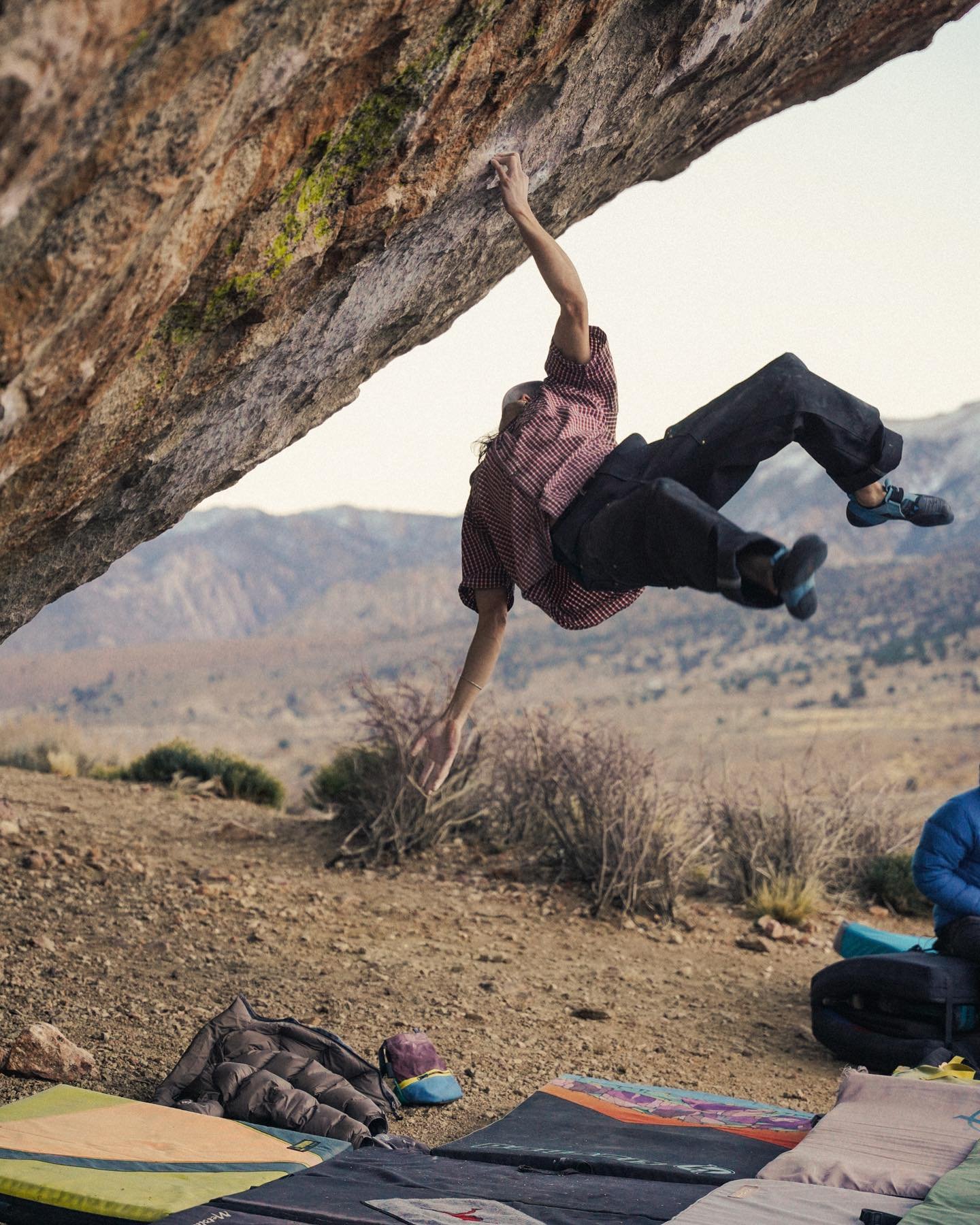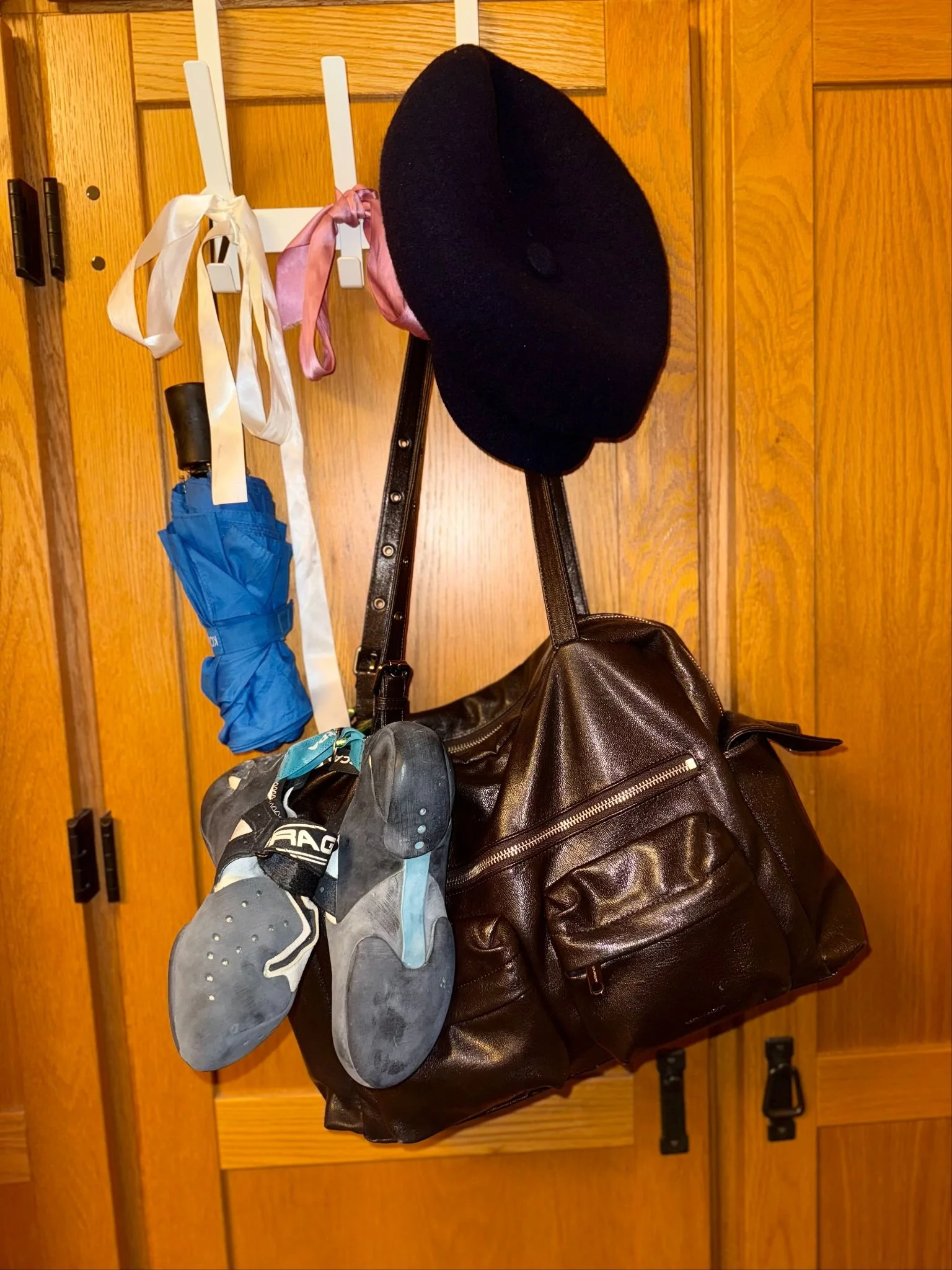MOSAIC: Bouldering En Vogue and Active Fashion
Photo Credit: Mina Lavapies
Are you a fashion fiend with a fear of heights? I’ve got an extreme exposure-therapy prospect for you. From a perilous hippie sport of the 70s to a fitness-centered manufactured experience in the later 2000s, rock climbing has seen a variety of phases alongside its steady rise in popularity. Bouldering—a shortened ropeless subsect of climbing—has particularly seen a huge increase in participants. It’s arguable that in 2025, bouldering has become the newest hot cosmopolitan activity appealing to both young trendsetters sporting matching LuluLemon sets and Bay Area tech bros dripped out in Arc’teryx. Fun, colorful, and exciting, bouldering has been entered as an option into the collective of potential first dates, hangouts, and trendy workouts with the promise of an upper body workout (especially since Carrie Bradshaw-esque “pilates arms” have increasingly become the pinnacle of pursuit in the realm of fitness trends). Part of the sport’s rise to fame is rooted in its premiere into the 2021 Tokyo Summer Olympics where audiences across the world bore witness to the gravity-defying acts and utter grace of professional climbers going for gold. While not previously unknown, climbing has since experienced a growth spurt of alarming degree, gym mats overflowing with new members eager to scale to great heights and bringing in new attitudes, enthusiasm, and fashion.
Doug Mills/The New York Times
Mosaic
Clothing has always been an essential component of any athletic activity, spandex and nylon dominating sports brands, and athleisure becoming unfortunately normalized in increasingly unathletic circumstances. I won’t lie and say that this isn’t for a valid reason (though I do think that wearing an Alo onesie to discussion and nothing else is doing too much), leggings allow for ideal mobility, and the infamous Nike Pros are actually fairly ideal for dynamic movement. However, it also would be heretical not to acknowledge that climbing, unlike many other sports, does not have a uniform dress code and thus demonstrates a remarkable diversity of apparel. Let’s take Mosaic Boulders as a case study, located on Telegraph a mere two blocks from UC Berkeley’s campus. If you’re a Berkeley student, you’ve almost certainly passed by and paused at the amalgamation of colors enticing behind the tall glass windows and perhaps even tested your fear of heights and finger strength on the perilous routes.
Mosaic Boulders
The gym’s extremely close proximity to such a large college campus aids in bestowing a more eclectic style identity upon the community that other more commercialized and millennial-filled facilities such as the Touchstone gyms may not experience as much due to the young and experimental ideas of the youth, malleable to rampant modern trends. The dare-devil extremeness of climbing aligns with parts of the skater-aesthetic, the need for a full range of motion appeals to the bagginess of street-style, and the primarily anaerobic nature of bouldering is inviting to all who just don’t want to get too sweaty working out (though if you’re sweating that means you’re working hard, which is generally a good thing).
Mina Lavapies
During his shift behind desk, monitoring the ebb and flow of climbers, Mosaic employee Edwin Kim sports baggy jeans, a plain black shirt, a hoodie from Mellow Climbing, and Docs. His look is completed with statement earbuds hanging out of the neckline of his hood, the overall fit balancing casual and cool, work attire and climbing convenience, and acquired nonchalance without overt try-hard. Favoring a baggier silhouette, Edwin’s ensemble is easily adaptable to boulder in but also would hardly look out of place anywhere else on Telegraph or campus. While he remarks that he cares about his style and puts thought into its practicality and aesthetics, he momentarily ponders before adding that he “doesn’t want fashion to be more important in the climbing gym than actual climbing” (Edwin Kim, Junior). So really, then arises the ultimate question: at what point does fashion enhance climbing and at what point does it feed into superficial fixations that denounce its true nature?
Mina Lavapies
Perhaps anonymous Mosaic employee number two can provide some insight. This advanced climber also wears a climbing-adaptable style with a dark plaid short-sleeve vintage button-up, clogs (Docs as well), and thrifted, double-knee, distressed-denim, custom-wash, Carhart pants (though despite their elaborate design, they’re apparently a little too heavy for comfortable climbing). This employee argues that fashion is a method of attraction, welcoming newcomers and allowing for greater diversity in the community; if you see someone dressed like you, it’s easier to feel comfortable in a new environment. This feeds into a parallel argument surrounding rising brand names in the climbing industry such as the wildly popular and wildly expensive outdoor brand Arc’teryx. With their more exorbitant pieces going for over a whopping $700, Arc’teryx has revolutionized both the fashion and outdoor scene with its gorp-core-esque attire. Not exactly accessible if you ask me, especially as, more and more, we see this brand used as a socio-economic statement in everyday style rather than in the extreme sports they’re designed for. If an outdoor apparel brand is employed inactively, what’s the point of it anymore, other than as a purely aesthetic object devoid of the purpose it’s designed for?
mfs after they gat an arc’teryx jacket
Arc’teryx
To be honest, I wouldn’t place all the blame on Arc’teryx itself. Yes, their stuff is pricey, yes it slightly kills me to see a first-time climber flexing their Shell Jacket indoors in 85º weather, but at the same time I understand the allure. The way they promote their clothing is ridiculously cool, showcasing their garments in action with world-renowned runners, snowboarders, skiers, and climbers.
Mason Mashon/ Arc’teryx
Ryan White/Arc’teryx
Their bird fossil logo is recognizable yet mysterious, the silhouette of their jackets sleek and sexy, their quality verifiably speaks for itself, and I won’t argue that wearing their pieces isn’t an easy hack to elevate one’s outfit instantaneously (that goddamn beanie). Arc’teryx looks good, feels good, and is high-functioning too. But something about the way so many people wear it so inactively still feels unsettlingly wrong.
Mina Lavapies
Mina Lavapies
Kelly Ng, Arc’teryx NorCal ambassador and incredible world-class climber, has some thoughts on the matter. To preface: if you ever get the privilege of watching Kelly in her element, she practically floats up the wall, performing an insanely technical, powerful, and graceful dance fifteen feet up in the air. Her partnership with Arc’teryx is not only a testament to her great ability but also to the brand’s utility, comfort, and swag. She views its rising popularity as a manifestation of climbing’s shift towards the mainstream given the influx of young people engaging with the sport. She believes that people can do what they want and wear what they want with their own money while acknowledging the complexity of the argument by stating that the focus of Arc’teryx should remain as an outdoor brand (Kelly Ng, Junior). I believe in Kelly’s argument, particularly when taking a look at the history of climbing where no one seemed to care so much about fashion faux pas.
OG Homage
It’s incredibly important to highlight some of the OGs who have pushed this sport to its limits, and for the sake of this article, their stylistic preferences. Lynn Hill, the woman that you are. A dominant force of nature, Lynn Hill has been barreling through barriers in climbing, gender equality, and flair for many years. Perhaps you’ve heard of Alex Honnald’s soloed ascent of El Cap in 2017, but how about Hill’s free climb of the Nose in Yosemite back in ‘93, making her the first person, man or woman, in history to accomplish such a feat? She’s fearless, she’s fierce, and she looks good doing it.
There are countless other climbing greats: Daniel Woods, Chris Sharma, Marc-Andre Leclerc, but fashion didn’t have such a relevance in their era and attire was just a means of sending harder. With the newer generation of greats, we see a shift. Ashima Shiraishi (V15 climber) has always stayed fitted with her signature capris pants,
Andrea Laue
Brooke Raboutou (2024 Olympic silver medalist) is walking runways for The North Face at Paris Fashion Week, and Shawn Rabatou (V17 Climber) has helped to plant the seeds for climbing brands through Mellow Climbing and its merch (shoutout Edwin Kim for repping the brand in his day to day style).
Vogue Runway
Mellow Climbing
Fashion’s ever-growing importance to climbing is evident in Sean (Steezy) Bailey outfits: going more skate-style with cuffed Carhart pants, a cap, and a plaid button-up on Devilution(V16) and belted baggy jeans on Shaolin(V17).
John Kasaian
Scarpa
Kawa, Mellow, Karma, Hitorii, Anti-Grav, and All the Sick Stuff You’re Probably Missing Out On
Zooming in on brands similar to Shawn Raboutou’s Mellow Climbing, small clothing businesses within the community are quickly on the rise. But will they just stay “within” the community or transition to the mainstream following the route of Arc’teryx? Diego Wong is another Arc’teryx NorCal ambassador and an ambassador for Kawa Club, a smaller climbing-specific brand known for their bright and loose pants. In an interview with Diego, we discussed this noticeable shift away from the old look that featured simple athletic clothing towards a new one generated by modern hype culture. While many climbers seem to worship the dated looks and the old-school climber aesthetic derived from the granola, van life, dirtbag-esque lifestyle, to the point of gatekeeping the sport, Diego argues that the older people of that generation don’t really seem to care about the aesthetics, they mostly just cared about climbing hard. “Trying to preserve an old school aesthetic is like trying to preserve something that doesn't exist” (Diego Wong, Senior). Given that outdoor climbing is naturally unchanging, it doesn’t make sense to force indoor gym climbing to remain stagnant as flashy competition style climbs are on the rise, style trends are just starting to push into the community, and, unlike the stationary granite of the outdoor world, the gym walls reset every week. Diego likes that climbing outfits are starting to become more expressive and they find it incredibly cool to see the visual diversification of the sport with smaller brands. While Mellow has more of a simplistic skater style, Kawa goes for bright visual appeal; other brands like Karma8A and Hitorii have taken on edgier and cool-toned approaches, whereas brand Antigrav is just sort of an intersection of everything: creative, serious, playful and overall mega sick.





Mellow Climbing, Kawa Climbing Club, Karma, Hitorii, Antigrav
Whether these brands truly hit the mainstream is really a question of whether the popularity of bouldering will continue to rise and reach a large enough audience. For one thing, these smaller brands are nowhere near as expensive as Arc’teryx, for another, I’m very biased, and they may only be cool in the context of climbing society and my own personal opinion.
Bags, Bags, Bags
Alright, before wrapping up, a quick inspection is warranted of the way people carry their climbing gear in tow. Or shall I say in tote. There’s a noticeable trend of people using their climbing shoes as a carriable accessory clipped from their bag of choice. Whether jostling from the back of a North Face backpack or fastened to the strap of a vintage shoulder bag, the sleek curved soles and rubber toes are barred to the open air. Perhaps climbing shoes on bags will become the next big thing as bouldering uptrends, or perhaps it will remain obvious only to a niche minority, but I will admit despite mixed feelings about the flauntiness of the large accessory, I find it objectively rather chic.
I love a good juxtaposition, and bouldering gear is natural material for great contrast, in particular the couture girl and the climbing shoe. Next time you’re looking in the mirror and wondering what your archival Vivianne Westwood jewelry, wired earbuds, flea-market-find Coach bag, carefully configured outfit is missing, consider picking up a new activity.
Conclusion
For some, rock climbing is a hobby to do with friends in between classes, for others it’s an entrenched lifestyle. I can’t predict how the sport will develop in the future, but I can confirm that on a global level, climbing has already entered the fashion sphere. Though I won’t say for sure that OGs like Daniel Woods haven’t always had separate wardrobes for their Dior and Prada, bouldering in particular is just beginning to develop in an apparel-minded way. Even at national competitions, clothing is a means of communication and athletes often exchange jerseys to show goodwill and gain mementos (Catch Kelly wearing her team Croatia shirt at the gym). It doesn’t matter what level you are (though I stand by my thought that head-to-toe dripped out Arc’teryx brings a slightly bad rep), wear what makes you feel brave, cool, and sexy if you think it will push you to climb harder. Don’t overthink it. Especially since at the end of the day, climbing is about climbing not whether your tights clash with your top. Especially since you’re very likely to see someone else at the gym dressed from the same Pinterest board. As much as clothing divides people, it also brings together communities, uniting different styles, personalities, and people into the mosaic we see today.























